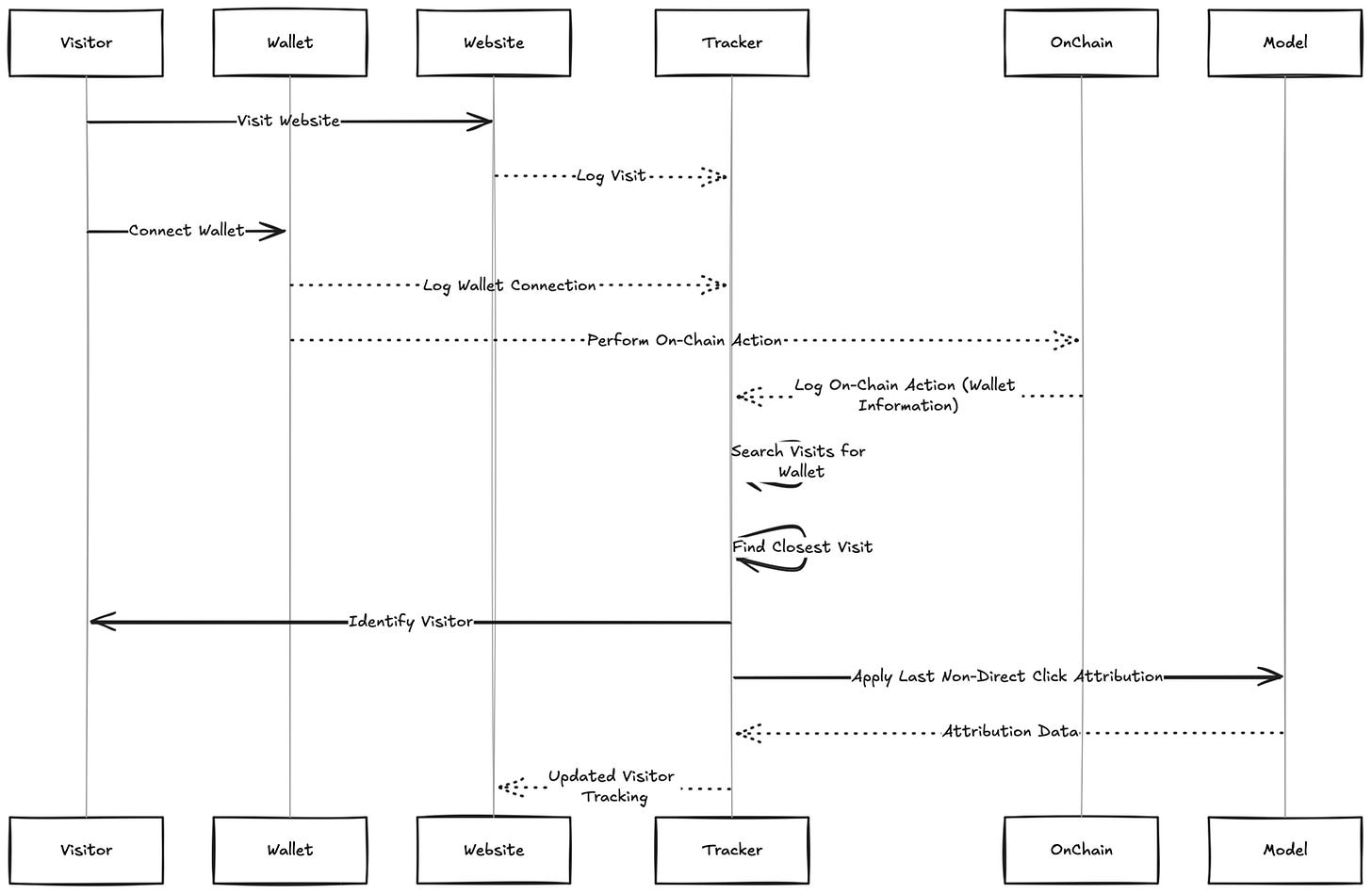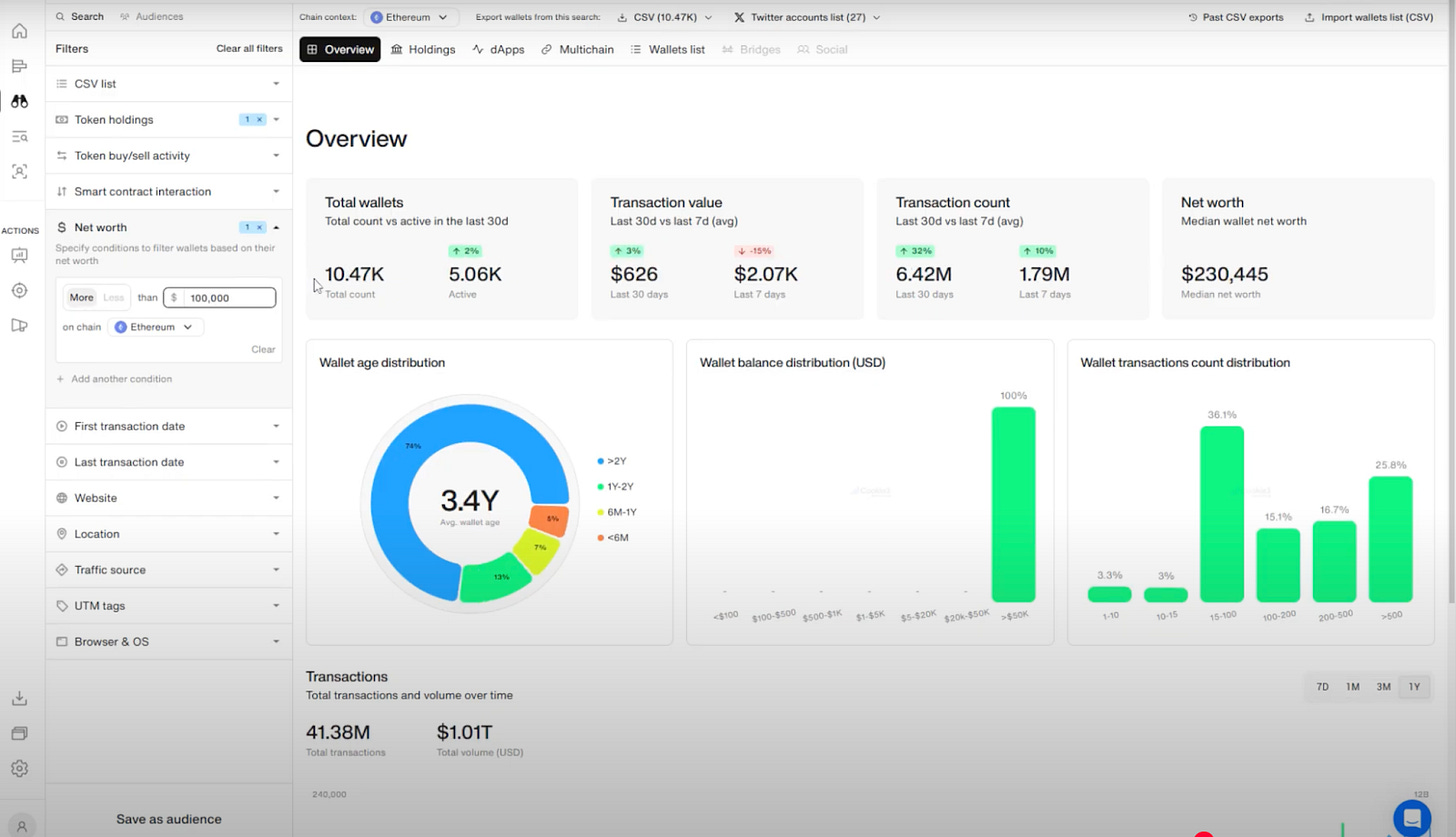Overview
Cookie3 Analytics is a comprehensive Web3 growth platform that bridges the attribution gap between traditional analytics and on-chain user behavior. Unlike standard analytics tools that lose users at the blockchain boundary, Cookie3 deterministically connects website visitors to their actual on-chain actions across 15+ EVM-compatible networks, with Solana and TON support coming soon.
Unified attribution tracking from website visits and wallet connections to on-chain conversions (swaps, mints, governance actions), regardless of traffic source
Multi-chain conversion monitoring across Ethereum, Polygon, Arbitrum, Base, Optimism, and 10+ additional EVM networks with real-time event processing (Solana and TON support coming soon)
AI-powered KOL intelligence that correlates social media engagement with actual on-chain impact and token performance
Advanced audience segmentation using on-chain behavior patterns (wallet age, net worth, protocol interactions, token holdings)
Developer-friendly integration via JavaScript SDK with REST API access for programmatic campaign tracking and referral management
Ideal for DeFi protocol teams, Web3 marketing managers, and technical founders who need quantifiable ROI measurement from marketing spend to actual blockchain activity rather than vanity metrics like website visits.
What Works Well
Deterministic Marketing Attribution Solves the Web3 Black Box Problem
The most technically impressive aspect of Cookie3 is its deterministic attribution model that connects website visitors to their subsequent on-chain conversions using wallet addresses as the linking identifier. When a user connects their wallet during a website session, Cookie3 can later attribute any on-chain actions from that wallet back to the original visit, whether the user arrived from a marketing campaign, direct navigation, or any other source.
This capability enables cross-platform attribution where conversions happening on external interfaces (like DEXs or NFT marketplaces) can still be tracked back to original marketing sources. This level of cross-platform attribution is impossible with traditional Web2 analytics and represents a fundamental breakthrough for Web3 marketing measurement.
For teams struggling to justify marketing spend, this capability transforms decision-making from gut instinct to data-driven optimization. Instead of hoping that 10,000 Twitter impressions translate to protocol usage, you can definitively track which campaigns drive users who actually deposit contributing to meaningful TVL.
Multi-Chain Infrastructure Eliminates Analytics Fragmentation
Cookie3’s native support for 15+ EVM-compatible blockchain networks with protocol-specific event monitoring eliminates the complexity of maintaining separate analytics infrastructure for multi-chain deployments. The platform automatically indexes smart contract events across Ethereum, Polygon, Arbitrum, Base, Optimism, Mantle, and emerging L2s, with Solana and TON integration planned, providing unified dashboards regardless of where conversions occur.
The technical implementation uses dedicated indexing infrastructure that processes over 15.5 billion transactions, with event detection happening at the smart contract level rather than relying on centralized APIs that might miss transactions. This infrastructure depth particularly benefits protocols deploying across multiple networks who previously faced choosing between incomplete analytics on each chain or building custom indexing solutions. Cookie3’s approach scales seamlessly as protocols expand to new networks, with testnets supported for development workflows.
AI-Powered Social Intelligence Quantifies Community Impact
Cookie3’s KOL Intelligence module represents a unique capability that no direct competitor offers: the ability to correlate social media activity with actual on-chain outcomes using AI-driven scoring models. The system continuously monitors Twitter accounts, tracking engagement metrics, hashtag performance, and timing correlations with token price movements or protocol interaction spikes.
In practice, this means being able to answer questions like “Did that influencer’s thread about our protocol actually drive new users to provide liquidity, or just generate empty engagement?” The AI scoring system evaluates factors including follower authenticity, engagement quality, and subsequent on-chain activity to provide quantitative KOL performance metrics.
Advanced On-Chain Audience Profiling Enables Precision Targeting
Cookie3’s Onchain Explorer functionality provides unprecedented visibility into user quality and behavior patterns using blockchain data that traditional analytics cannot access. The platform automatically profiles users by wallet age, net worth, DeFi protocol interactions, NFT holdings, and cross-platform activity to create sophisticated audience segments.
The technical implementation goes beyond basic wallet tracking to identify behavioral patterns like “whales” (wallets >$100K), “OGs” (wallets >2 years old), and protocol-specific user types. You can create audiences combining multiple criteria - for example, “wallets holding competitor NFTs with >$10K net worth who visited via our latest campaign” - enabling highly targeted analysis and potential outreach strategies.
This capability proved valuable for understanding user quality across different acquisition channels. Cookie3 can reveal whether users arriving from certain marketing channels consistently have higher wallet values and longer engagement patterns, while others attract predominantly short-term participants who exit positions quickly (https://docs.cookie3.com/cookie3-analytics/features/onchain-explorer/audiences).
Implementation Considerations
Attribution Dependency on Wallet Connections Creates Selective Tracking Gaps
Cookie3's attribution model has a documented technical limitation that affects its attribution coverage: it can only link marketing campaigns to on-chain conversions through two primary methods - either users connect their wallets during the website session, or campaigns use Cookie3's UTM parameter and referral link systems. Users who discover protocols through social media and interact directly with smart contracts without visiting the marketing site or clicking tracked links remain untracked, creating attribution gaps in certain user acquisition scenarios.
This limitation particularly affects direct-to-contract interactions where sophisticated users engage with protocols through aggregators, alternative frontends, or programmatic interfaces without passing through trackable touchpoints. However, Cookie3 provides several mitigation strategies including UTM tracking, custom referral codes, and referral API systems that can capture conversions without requiring wallet connections.
The practical impact varies significantly based on implementation strategy. Projects using Cookie3's full attribution toolkit - including referral links, UTM parameters, and wallet connection incentives - report achieving 20-25% wallet connection rates with measurable ROI improvements. Cookie3 processes over 15.5 billion transactions across multiple chains and claims clients achieve 64% reductions in marketing spend through improved attribution.
Teams should implement comprehensive tracking strategies combining multiple Cookie3 attribution methods: UTM-tagged campaigns, referral link systems for influencer partnerships, and user flow optimization to encourage wallet connections where valuable. While true attribution coverage cannot reach 100% due to the decentralized nature of Web3 interactions, Cookie3's documented workarounds significantly reduce attribution gaps compared to wallet-only tracking. Projects should evaluate this limitation against Cookie3's multi-chain support, KOL intelligence features, and proven case studies showing substantial marketing efficiency gains.
Real-Time Processing Claims Lack Specific Performance Metrics
While Cookie3 markets its analytics as “real-time,” the platform provides no documented latency specifications for how quickly on-chain events appear in dashboards or how frequently data refreshes occur. This uncertainty creates challenges for teams requiring immediate feedback for campaign optimization or risk management decisions.
The lack of specific performance metrics means teams should plan analytics workflows assuming processing delays rather than instantaneous updates. Cookie3 should provide specific SLAs for data freshness and consider offering webhook notifications for immediate critical event alerts to address time-sensitive use cases (no official latency documentation available in public docs).
Integration Flexibility Limited Beyond Browser-Based Applications
Cookie3's integration architecture centers around browser-based JavaScript implementations with deliberate focus on web analytics rather than comprehensive omnichannel tracking. The platform supports major web frameworks including Next.js, Nuxt.js, Webflow, Framer, and Telegram Mini-Apps, with one-click Google Tag Manager integration providing additional deployment flexibility beyond the primary CDN snippet method.
The NPM package hasn't been updated in over two years (version 0.6.0), indicating Cookie3's strategic shift toward CDN-hosted snippet integration as the primary supported method. For teams building native mobile applications, Cookie3 recommends WebView integration rather than native SDKs. Server-side tracking requires workarounds through the referral API or CSV exports, as no dedicated server-side API exists for general analytics data.
API access remains limited by design, with the beta REST API primarily serving referral and conversion data rather than comprehensive analytics exports. Teams requiring extensive programmatic access to analytics data must rely on CSV exports from the dashboard or the referral-specific endpoints.
This web-first approach aligns with Cookie3's positioning as browser-based Web3 analytics rather than attempting full omnichannel coverage. Projects needing comprehensive mobile app tracking or extensive server-side event logging should evaluate whether Cookie3's documented WebView workarounds and referral API proxies meet their technical requirements, or consider supplementing with additional analytics tools for non-web touchpoints.
Overall Assessment
Cookie3 Analytics represents one of the most sophisticated solutions available for Web3 teams serious about measuring marketing effectiveness beyond vanity metrics. Its deterministic attribution model and multi-chain infrastructure deliver capabilities that simply don't exist in traditional analytics platforms, making it essential infrastructure for data-driven Web3 project management across gaming, NFTs, infrastructure, and DeFi.
Teams managing Web3 projects with significant marketing budgets and multi-chain deployments should consider Cookie3 a necessary investment rather than an optional tool. The platform's ability to connect marketing spend to actual on-chain conversions - whether NFT mints, token transactions, governance participation, or protocol interactions - creates immediate ROI through campaign optimization and budget reallocation toward effective channels.
However, teams with primarily mobile-native experiences or complex server-side architectures may find the browser-centric integration limiting until Cookie3 expands its SDK offerings. Early-stage projects should also carefully evaluate whether the wallet connection dependency aligns with their user experience priorities, particularly for consumer-facing applications where wallet friction remains high.
The platform particularly excels for projects where understanding the intersection of social engagement and on-chain behavior drives strategic decisions. Cookie3's unique combination of KOL intelligence and cross-chain attribution creates competitive advantages that justify the investment for any Web3 project serious about growth measurement. While competitors like Spindl focus on advertising infrastructure, Cookie3's strength lies in deep community analytics that reveal not just who converted, but why and how community dynamics influence actual blockchain adoption.
For teams operating community-driven Web3 projects - including gaming platforms tracking player acquisition, NFT marketplaces measuring creator campaign effectiveness, infrastructure projects monitoring developer adoption, or DeFi protocols optimizing liquidity programs - Cookie3 offers data-driven attribution capabilities that reduce reliance on assumption-based optimization. The platform's ability to handle complex attribution challenges across multiple chains and social platforms makes it valuable regardless of vertical focus, especially where token economics or governance participation creates measurement complexity that traditional analytics cannot solve.
Technical Details
Pricing: Entry tier at $49/month (basic analytics), mid-tier at $249/month (full on-chain features), growth at $599/month (unlimited features, priority support) and Enterprise plan (API access, custom features)
Access Requirements: JavaScript integration via CDN snippet, API key authentication for referral tracking, wallet connection required for attribution linking
Supported Networks: Ethereum, Polygon, Arbitrum, Base, Optimism, BNB Chain, Avalanche, Mantle, Fantom, plus testnets; Solana and TON coming soon (EVM-focused currently)
Learning Curve: Medium - requires understanding of Web3 analytics concepts and wallet-based attribution, but comprehensive documentation reduces onboarding complexity
Documentation Quality: Excellent - comprehensive GitBook documentation with integration guides, API references, and troubleshooting at
https://docs.cookie3.com
Integration Options: JavaScript SDK via CDN, Google Tag Manager support, REST API for referral data, CSV export functionality
Support: In-app chat (Intercom), Telegram community, email support; response times vary by plan tier







